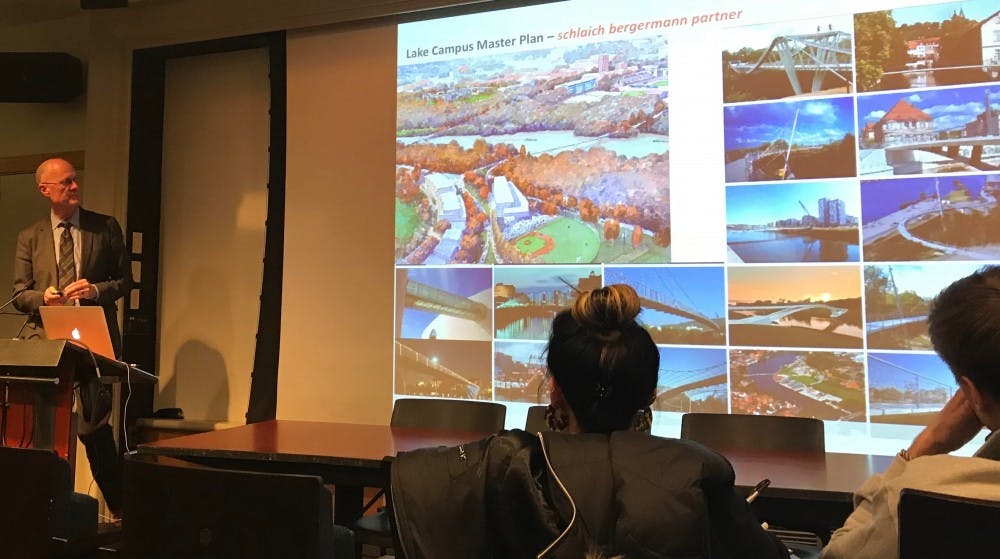In response to student questions, President Christopher Eisgruber ’83 again argued against “Ban the Box” initiatives at the Council of the Princeton University Community (CPUC) meeting.
University administrators and campus partners also presented on potential changes to academic integrity discipline. Details of the expanded campus, like specific new buildings, were also discussed.
Held six times each year, CPUC meetings are an official platform for students and community members to discuss initiatives with University officials.
In Monday’s meeting, Eisgruber maintained his stance that the University should continue asking about conviction status in the undergraduate admissions process.
“We hold people accountable for the actions that they have taken, while at the same time seeking to get students from all kinds of groups within society,” Eisgruber said.
“But when there are students, for example, on our own campus who cheat or who hurt others in what they do, we don’t regard that as a ‘perspective’ that we want more of on campus,” Eisgruber said. “Those are grounds for, actually, removing students from the campus. And that’s why we take these actions very seriously when we make the decision about whom to admit and who not to admit.”
In his arguments, Eisgruber said the University recognizes “various kinds of bias” in society, and said that’s why the University asks for undergraduate applicants’ race in a holistic admissions process.
However, he said, the University does not see these biases as a reason to “simply excuse or disregard evidence of misconduct.”
Eisgruber did note that prior conviction status does not necessarily rule out an applicant.
He mentioned, as he did in the previous CPUC meeting, the possibility of restructuring the question “in ways that may mitigate some of the negative effects.”
“Where there are possibilities that people may have engaged in serious kinds of wrongs,” Eisgruber added, “we’re not simply going to ignore that evidence.”
Following the discussion on “Ban the Box,” at least 25 students left the meeting.

Afterward, Dean of the College Jill Dolan presented an update on the Academic Integrity Reconciliation Committee.
The committee was charged to make recommendations following reports on last year’s Undergraduate Student Government (USG) Honor Code referenda from the Honor System Review Committee (HSRC) and Faculty-Student Committee on Discipline (COD).
Some committee recommendations involved standardizing punishment processes. Right now, the Committee on Discipline and the Honor Code have the power to assign different penalties for similar offenses.
Dolan mentioned the possibility of standardizing Committee on Discipline and Honor Committee penalties, and said that students should receive the same punishments from the Committee on Discipline and the Honor Code for similar offenses.
Dolan also pointed out that the Academic Integrity Reconciliation Committee is looking into an expanded array of possible penalties for infractions. Both a one-semester suspension and the possibility of a “reprimand” are under consideration.
Dolan said she hopes the implementation of some recommendations will rid some of the “anxiety and confusion” of a “mystified” process of the past.
“The point is to acknowledge that there’s a difference between writing over time in an exam and doctoring an exam,” she said. “We want to be very aware of the differences and suggest that, perhaps, they demand a different kind of penalty.”
Currently, the minimum penalty for any Honor Code infraction is a one-year suspension.
Dolan also mentioned her hopes to ease the process of reentering the community after suspension, saying that she sees the process as an “attempt at restorative justice.”
Caleb Visser ’20 asked Dolan whether she feels calendar reform would ease the implementation of a one-semester suspension. Dolan replied that “everything will be easier” with calendar reform, though the two issues have been considered separately.
Other committee recommendations revolved around education, and Dolan emphasized transparency.
“We need to do a better job educating both students and faculty about the expectations and procedures,” she said.
Specifically, she said faculty must be clear on what it means to end an exam and how to clarify their expectations for students.
The committee expects to forward recommendations to Dolan, Dean of the Faculty Sanjeev Kulkarni, and Vice President for Campus Life W. Rochelle Calhoun by the end of January 2019.
University Architect Ron McCoy also presented on the University Campus Plan, put together between 2014 and 2017.
McCoy called the plan, “a framework to guide campus development over the next 10 years in the context of potential needs and developments over 30 years and beyond.”
Prior to this generation of campus planning, he said, the University has focused on central campus.The University looked at the full extent of their land in the new plan, according to McCoy.
McCoy also laid out high-priority architecture projects, including a new residential college, and announced the architects hired for each project.
The construction of Perelman College, according to the presentation, will be headed by the architecture firm Deborah Berke Partners. The plan notes that the site allocated for the construction of Perelman College, south of Poe Field, “could accommodate a second college in the near or longer term.”
Other high-priority projects include the Lake Campus Plan, including a flyover over Lake Carnegie and Lake Campus Graduate Housing. The Lake Campus Plan also includes a relocated soccer field, racket center, and softball facilities across the lake. Those athletic facilities, currently north of the lake, will be relocated to make room for the new residential colleges.
The Lake Campus Master Plan will involve the firms Skidmore, Owings, & Merrill LLP and James Corner Field Operations, the landscape architecture firm famous for designing and constructing the High Line in New York City.
The plan also includes new and improved facilities for teaching and research in engineering and environmental studies. Ennead Architects, the firm hired to construct those new facilities, has built engineering facilities at Vassar College, the University of Michigan, the University of Texas at Austin, and Stanford University.
Additionally, the plan includes a new building for University Health Services on Goheen Walk and a new University Art Museum at the site of the existing museum.
In his presentation, McCoy also pointed to the plan’s emphasis on sustainability. According to his presentation, the University is aspiring to be completely carbon neutral in 30 years, with new buildings designed to meet high sustainability objectives.
Without interruptions in fundraising, McCoy said he expects the campus changes to be made by 2024.
Visser, a Wilson College RCA, asked McCoy about how the additional residential colleges will affect disparities in living conditions on campus, noting the difference in living conditions in Wilson and Butler College.
McCoy, and others involved in the project, pointed out that though much of the plan’s focus is on expansion, it also directs funds for restoration.
Amanda Eisenhour ’21 asked McCoy why the University chose for American Campus Communities (ACC), a for-profit third-party company, to own and manage the Lake Campus Graduate Housing.
McCoy pointed toward the ACC’s “operational expertise.” Another faculty member involved in the project said he expects this expertise to help keep rent prices low for graduate students, since the facilities will be constructed and managed in a cost-effective manner.
The Dec. 10 CPUC meeting was held in Betts Auditorium. CPUC meetings are open to all members of the University community, and the next meeting will be held on Feb. 11.









